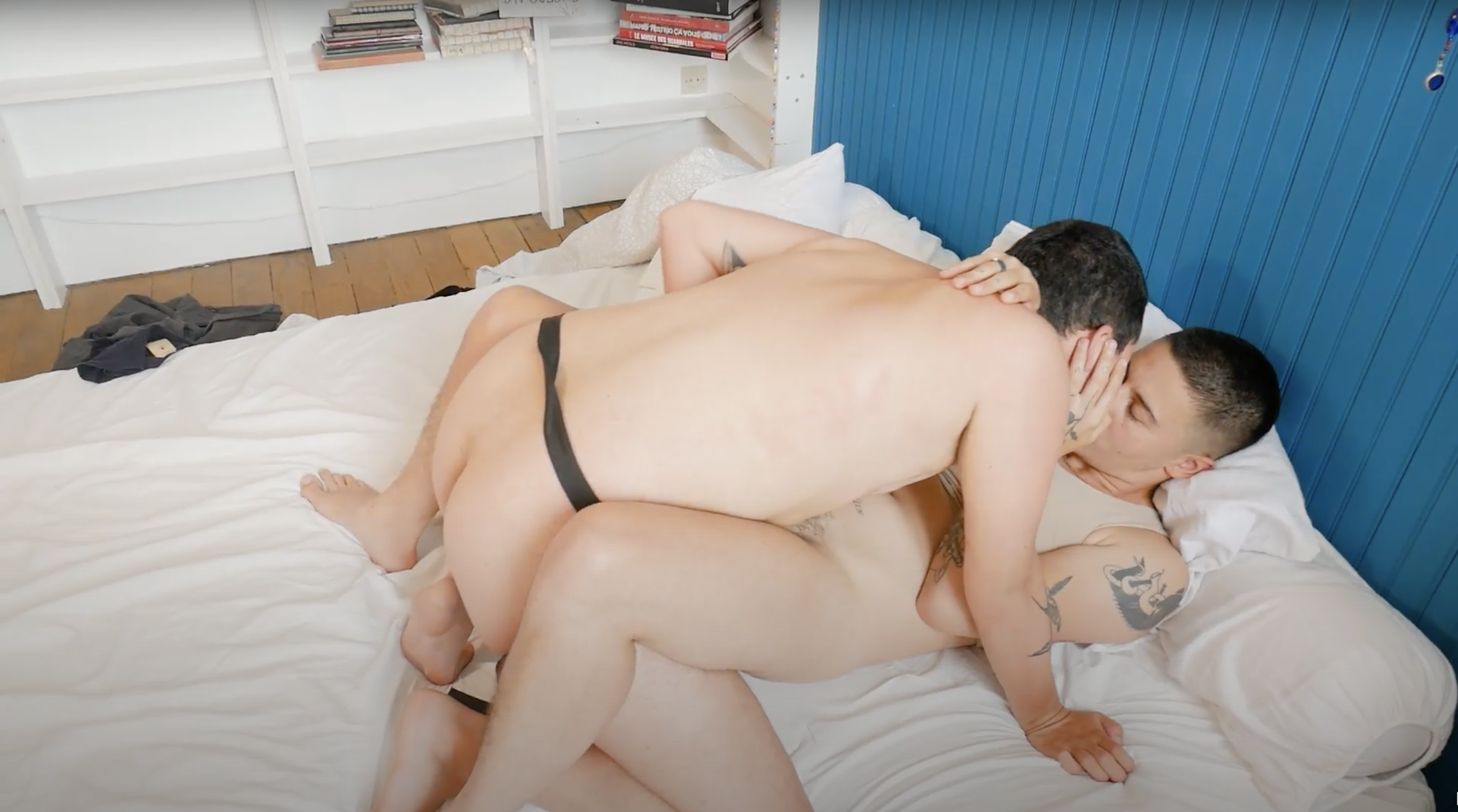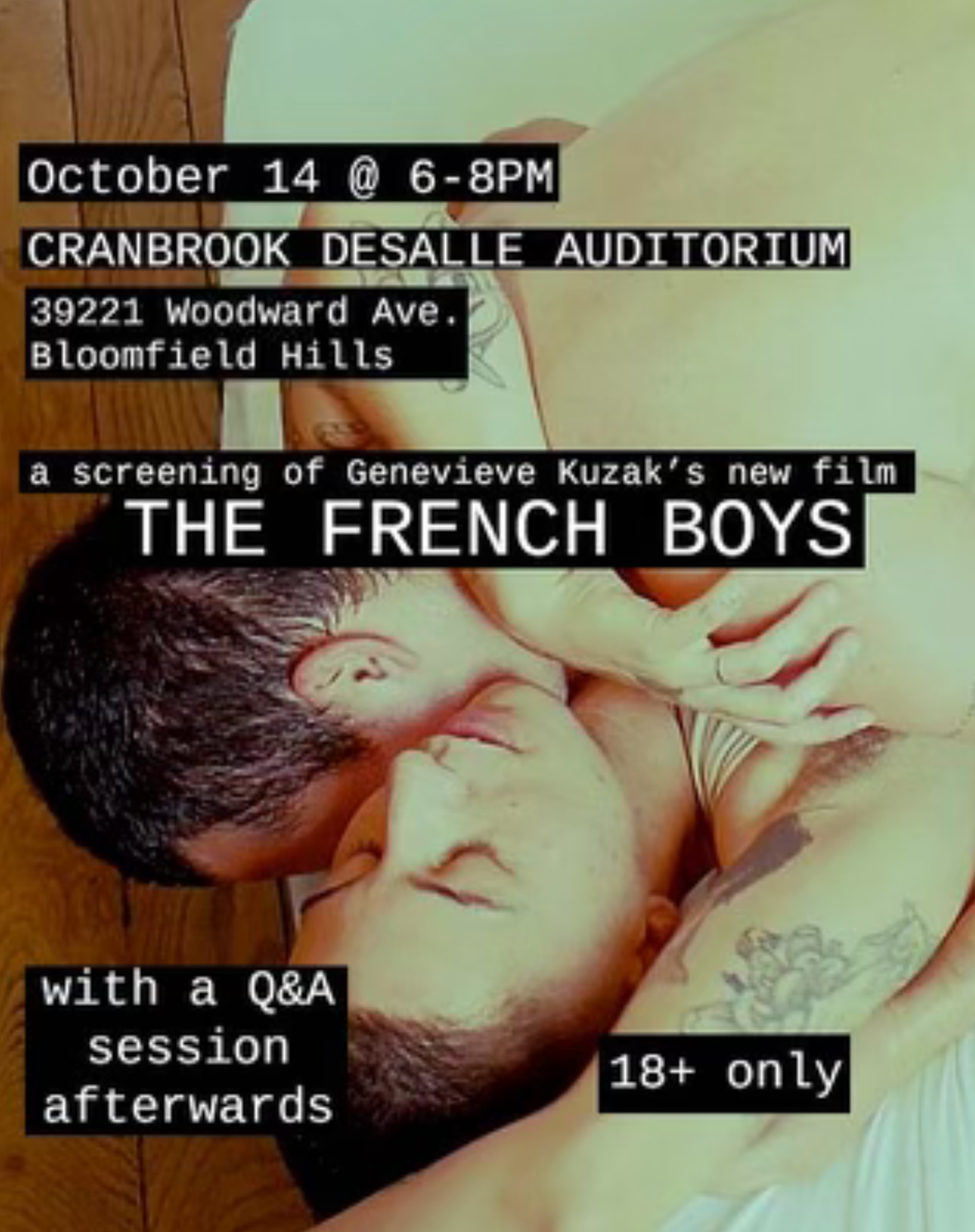
Ashley Cook
December 2, 2021
“...sometimes, when I can’t sleep...my hand wanders...while I imagine...two trans boys making love…”1
Gen Kuzak’s most recent pornographic film The French Boys premiered at the Cranbrook DeSalle Auditorium in Bloomfield Hills on October 14, 2021. The film features a transmasculine couple in Paris, France who responded to Gen’s call for actors after having also become fans of his work in recent years. Gen’s practice, which began at an early age, has often involved photographing and filming his friends to generate extreme and provocative imagery. From the start of his career, Kuzak has been recognized for his exploration of shocking and edgy subject matter, placing it center stage with a distinct focus on creating space to further explore a more transgressive approach to queer culture. The act of bringing this film into the academic setting of Cranbrook University certainly furthers that trajectory. The choice to debut this piece as a work of art before releasing it into the world of pornography allows it to immediately supersede established discriminations towards eroticism and sexuality that are upheld within this type of setting while also blurring the lines between art and porn. The French Boys forcefully pushes our mental space to consider what it means to exhibit a pornographic film within the art context, and for those who recognize this type of content to be at the very birth of image making, it is as if Kuzak had sent a cord through a portal of history, firmly lassoed the subject matter of the ancients and pulled it through thousands of years of deep time into the present day.

From early in his career, Kuzak explored and utilized the world of Tumblr to publish work with an eagerness to celebrate not only a comfort in sexuality and wildness, but to do so with a rawness and vulgarity. As Gen’s work continued to evolve using narratives to portray his subjects as characters in visceral fantasy worlds, Kuzak recognized a unique relationship between pornography and fantasy. It is with his first pornographic film American Pornography where Kuzak moved into a more intentional introduction of overtly erotic story lines that brought representation to butch masculinity. The camera and lighting techniques employed by Kuzak as well as the central characters being friends and close acquaintances make it easy for the viewer to wonder whether what they are witnessing is true life or staged and scripted. While reflecting on The French Boys, audience member Jane Wonch suggests this fantasy/reality dynamic to be further explored, noting that “as the film begins with writing on notebook paper, it seems to be introducing a vivid fantasy that goes from the paper into a real-life moment“. With inspiration coming from Mansurfer, Xvideos and the Saddistic Boy Hunter tumblr page, Kuzak actively explores a realm where pornography becomes an art form that takes on its own aesthetic and creates its own world, and something that makes Gen Kuzak’s work unique is the gaze that is coming from a butch perspective. “It is working to represent masculinity but in a way you don’t often see; a masculinity that is divorced from cis men.”2
“...I love the taste…
...of his fingers in my mouth…
...I love the taste…
...of his dick and his pussy…
...and his ass…
...I love it when…
...he chokes me…
...I love it when…
...he fucks me…
...I love it when I fuck him…
...I love it when…
...his fist is inside of me…
...I love it when…
...he kisses me…
...I love it when…
...he loves me…
goodnight :)”3
It is no argument that eroticism has been a major aspect of art since the concept of visual representation was invented, and with this history comes a plethora of different representations of sexuality. Although not commonly on display in public art institutions of the Western world, a deep dive into the history (and pre-history) of erotic art will reveal a wide presence of homoerotism. Briefly, this list begins with one of the earliest known cave paintings of Grotto Dell’Addaura dating back to 11,000b.c.e. that depicts what is perceived to be “a homoerotic ritual conducted by two shamans”.4 Peithinos Cup (525-475b.c.e, Athens, Greece) shows both “heterosexual and homosexual courtship”,5 Gustav Courbet’s The Sleepers (1866, Paris, France) depicts “women who love women”.6 A Turkish manuscript from 1773 made by illustrator Shaykh Muhammad Ibn Mustafa Al-Misri displays “an interconnected circle of penetration [of men] in matching fez hats”,7 Plate XVIII from De Figuris Veneris(Late 1800’s, France) by Édouard-Henri Avril features an MMF threesome.8 As a social, theoretical and linguistic framework continues to develop around queer sexuality in the West, age-old ways to describe various manifestations of gender and sexuality are uncovered to help us. Any currently enforced gender binary completely implodes when learning about genders of ancient cultures, which in some cases spanned to over 100 different acknowledged gender expressions that held essential space in the culture’s language and imagery.9 Holding space allowed these expressions to be understood and more widely accepted as a part of culture, or even more importantly, as part of nature.

Naturally, a world without representation is a risky place to be; the cost of invisibility can be devastating. Not only does it postpone self acceptance and self discovery for those who are under-represented, but it also casts them as outsiders who are mis-perceived, leading to discrimination and abuse. Queer and transgender identity has been around for centuries, but because it was not understood, it was usually explained away by cis-gendered people with presumptions of alternative intentions. Instead of being able to simply acknowledge the possibility of varying gender identities as authentic, modern society has upheld a resistance to any language that properly explained the presence of these experiences. As language evolves in the present time, it is also applied to the past in order to explain things that could not be explained with the limited language available back then. Quoting ballroom historian and archivist Sydney Baloue, “history is not a reflection of the past, it is a reflection of the present”.10 Contemporary language allows for new conversations to flourish and old terms to resurface after having been buried for so long. Moving forward, there has been a drive to expand representation and create more and more opportunities to share their stories from their own perspective; works like American Pornography and The French Boys make that happen. Pioneers like Gen Kuzak and other contemporary creative producers are getting their hands directly on the means of production to create trailblazing work that furthers the infrastructure and language of this representation. As Gen continues to present both eroticism and transgender identity as common and acceptable subject matter, there is growing gratitude for his work and what it does for the strength and power of the community.

1. Genevieve Kuzak, dir. The French Boys. 2021. Paris, France: premiere at DeSalle Auditorium, Cranbook University, October 14, 2021.
2. Genevieve Kuzak. “Premiere of The French Boys.” Question and Answer after screening, DeSalle Auditorium at Cranbook University, Bloomfield Hills, MI, October 14, 2021.
3. Genevieve Kuzak, “The French Boys.”
4. Hoke, Casey. “Grotto Dell’Addaura Cave Painting (11,000BCE).” July 15, 2018. Queer Art History. https://www.queerarthistory.com/tag/homoerotic/
5. Hoke, Casey. “Peithinos Painter - Peithinos Cup.” August 7, 2017. Queer Art History. https://www.queerarthistory.com/tag/homoerotic/
6. Hoke, Casey. “Gustav Courbet - Le Sommiel (The Sleepers).” August 7, 2017. Queer Art History. https://www.queerarthistory.com/tag/homoerotic/
7. Frank, Priscilla. “A Brief And Gloriously Naughty History Of Early Erotica In Art (NSFW).” July 28, 2015. Huffington Post. https://www.huffpost.com/entry/a-brief-and-gloriously-naughty-history-of-erotica-in-art_n_55b65df9e4b0224d8832ecb9
8. Frank, Priscilla. “A Brief And Gloriously Naughty History Of Early Erotica In Art (NSFW).”
9. Donegan, Siobhan. “Transgenderism in Ancient Cultures.” LGBT Health & Wellbeing. https://www.lgbthealth.org.uk/lgbt-health-blog/transgenderism-in-ancient-cultures/
10. “Panel: Focus on Transmasculinity in Film and TV.” Video file, 1:10:37. YouTube. Posted by GLAAD, February 23, 2021. https://www.youtube.com/watch?v=B1N4eeI7Osc